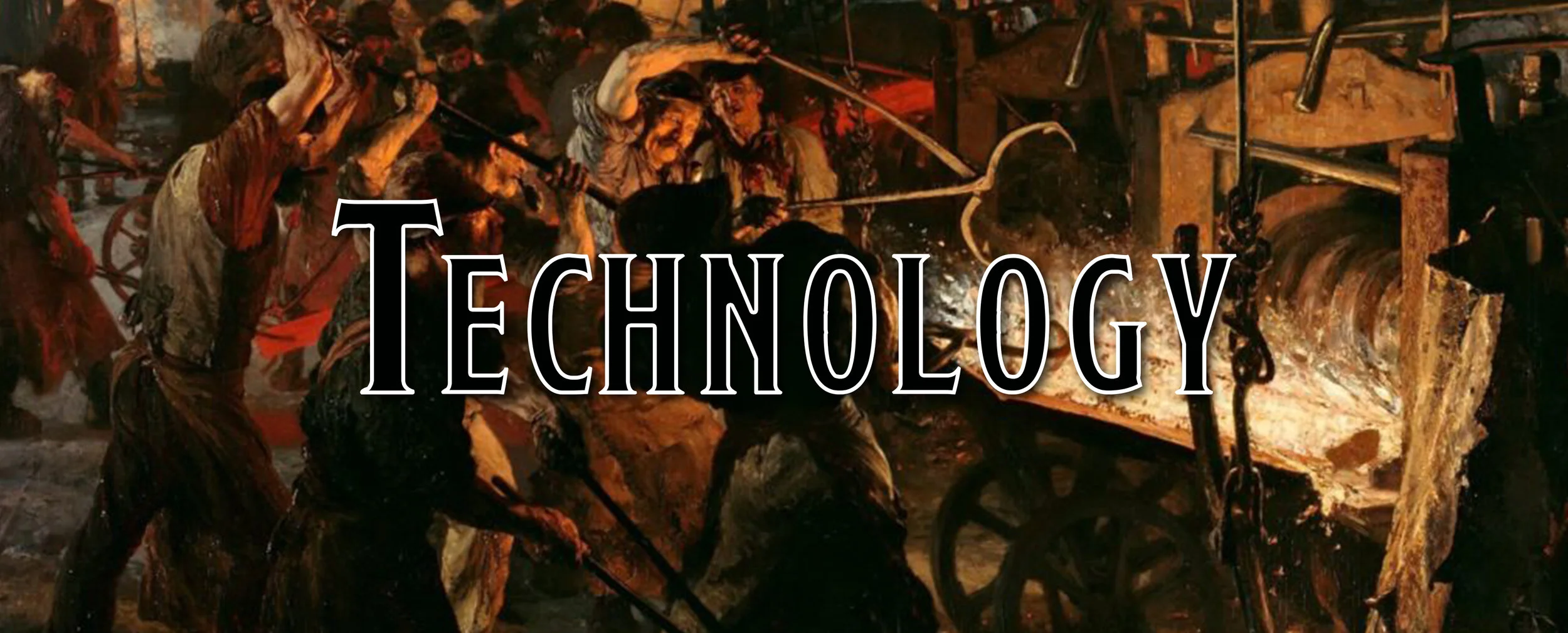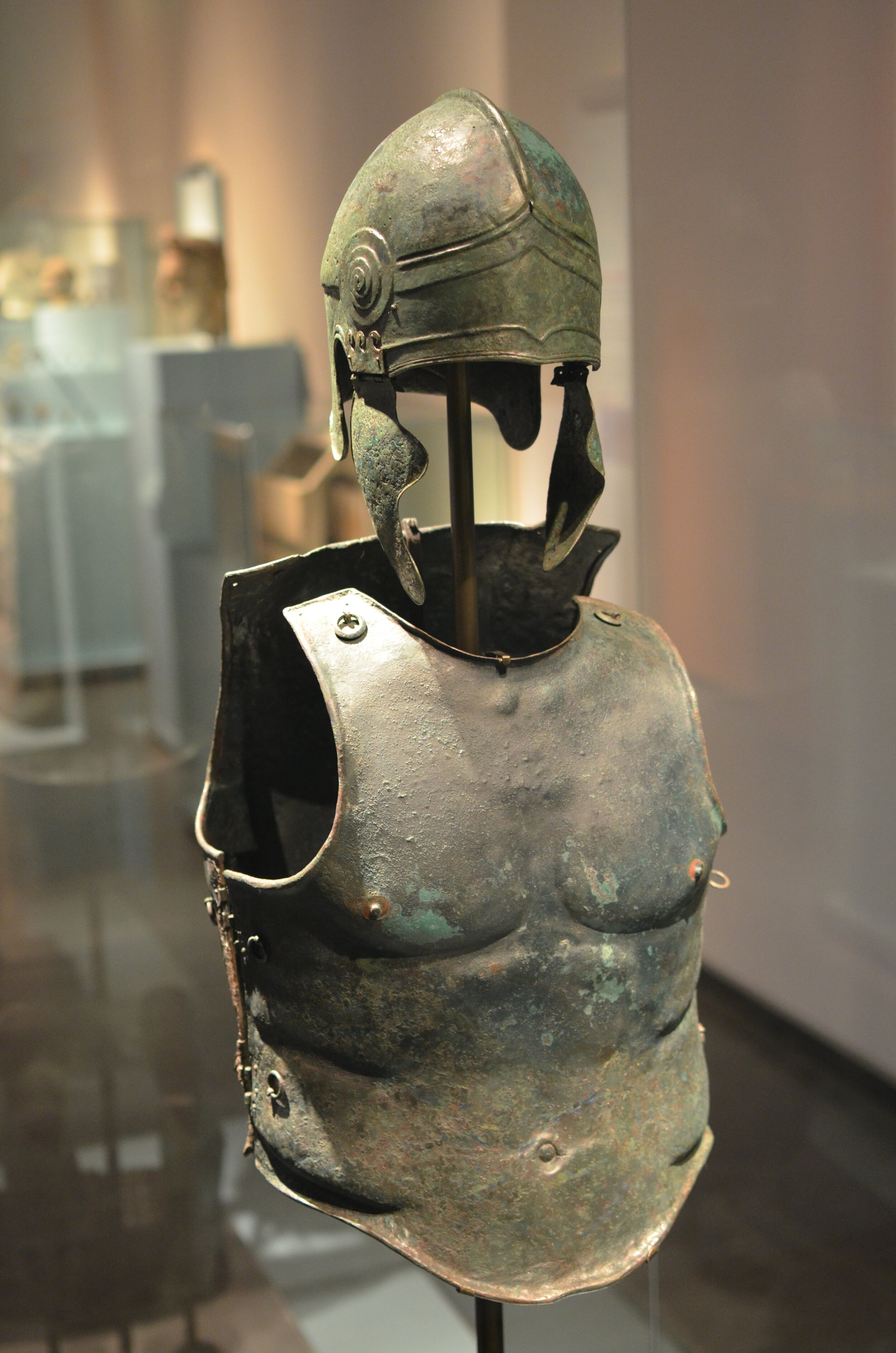The Advancement of Technology
Header Art: The Iron Rolling Mill by Adolph Menzel
Technology is a weird thing. Some people love the idea of weird and fantastical technology in their books, their games, and their media. Others just want to go prehistoric where fire was the hot new thing (see what I did there?) and have weapons and tools only made of bone that you have to punch out of a sabertooth tiger yourself. I, personally, like the meshing of magic and the Age of Revolutions leading into the Victorian era. That entire mish-mash is my jam.
That brings me back to my initial sentence, technology is weird. If you look at the history of humans, there are some things that take off in a flash and others wallow around for a few thousand years before they finally reach their final form, and then almost immediately become obsolete. Let’s look at the airplane, in 1903 CE the Wright brothers ‘flew’ for 12 seconds and by the end of the day, they were flying for 59 seconds. In 1915 CE, the earliest known aerial victory with a machine gun was documented. In just 12 years the airplane could fly for as long as the fuel lasted and perform complex maneuvers to avoid gun fire, crashing, and more.
It took only 12 years for technology to overcome gravity. It then took another 46 years before, on April 12, 1961 CE, for the first man to reach space. There would have been people born before flight was a possibility and died after Yuri Gagarin circled the world.
I should mention that there were others who were working on developing flight before the Wright brothers. Saying that aircraft were developed in 12 years is ignoring years of trying to get into the air successfully, I'm just comparing when we began effectively flying to how quickly it developed and ignoring hot air balloons that first took flight in 1783 CE.
The Technology of Plate Armor
Of course, talking about flight doesn’t have that much to do with most fantasy RPGs. While one of my parties has an airship, not every world is going to have zeppelins that carry their party from one city to the next. What most fantasy RPGs are going to feature though is something that has pervaded our assumptions of the Middle Ages.
Plate armor is, relatively, a new piece of technology. By relative, I mean in comparison to something like spears or swords or axes or even just armor in general. When you close your eyes and think of King Auther, you probably imagine knights in shining plate armor. In actuality, in the 5th or 6th century when King Arthur would’ve been alive, he’d probably wear some chain mail, maybe an iron cuirass, as well as a wooden helmet with some iron banding to give it some sturdiness. Other knights would wear similar kit, though it all depended on how much money they had and how much they valued their own life. It was up to individuals to buy armor for themselves and it was even passed down through the generations, armor was expensive and if your father’s cuirass kept him alive, why couldn’t it do the same for you?
Looking specifically at plate armor, it didn’t get fully developed until about 1420 CE and was only worn by the wealthiest due to its extreme costs. That’s pretty late for the Middle Ages, especially since most associate the fall of Constantinople in 1453 CE as the end of those ages. That means it, if we are being kind, had about 35 years where you could think Middle Ages and knights riding around in full plate armor.
And that really wouldn’t include the hundreds of knights you might be imagining! Blacksmiths can’t just pump out plate armor, even modern-day blacksmiths with machines to help still require at least half a year, if not more, to produce armor. If you are hoping to have plate armor permeate into your military, you had a brief period between the end of the 15th and beginning of the 16th century until firearms started becoming too widely spread, and cheap, to produce. They tore through ‘cheap’ armor, which is still expensive to produce, and if you really wanted to be safe, you’d have to wear thick armor that would be exhausting to spend much time in.
With that idea in your head, next time when you watch Lord of the Rings, marvel at every soldier's plate armor and how all the elves have such form-fitting, light armor. The production capabilities of those societies are astounding and would put even our modern factories to shame.
Long Time Coming
Plate armor had a long development cycle, it wasn’t 12 years and you go from some rickety nonsense to dogfights in the sky. It took a long time to get full body armor, but there were parts in early history where there were things akin to plate armor, just not as effective.
The earliest examples of ‘heavy armor’ would probably the muscle cuirass which was produced by the Greeks in the 5th and 4th centuries BCE. These were often worked pieces of bronze, though to cut down on costs, you could also use boiled leather. The cuirass would feature two pieces of armor, one for your front and one for your back.
This image of a muscle cuirass was found in Southern Italy around 340-330 BCE and the example includes a helmet and the two parts of the cuirass, not pictured are the greaves, heavy shield, sword, and a spear that a soldier would typically have. This was the full suit of armor if you could afford it and was the typical armor for hoplites and the free citizens of Greece who could afford such expensive armor. Again, if you were a soldier, you have to pay for your own equipment.
Of course, if you are one of the thousands and millions of people who were just common farmers, peasants, and commoners and were forced to join the army, hopefully, you could afford something or else you aren’t going to last very long. Some might have some armor that was made by linen being glued together in what is known as linothorax, but more often than not, you are just going with a shield and spear and praying to the gods that you get lucky.
After the muscle cuirass, there are different advancements that focus on different sections of the body. Armor for legs becomes available, bronze got swapped for iron and the armor got heavier and heavier as soldiers tried to come up with solutions to being killed. This age of development took from about 500 BCE to about 1420 CE as the wealthy sought every means that they could find to keep alive from battle to battle. Vast amounts of money have been spent to finally fuel the production of the plate armor... that was quickly outpaced by firearms.
Plate Armor & TTRPGs
Maybe you have grown a new appreciation for plate armor, seeing as how it took almost 2,000 years to develop, but what exactly does this have to do with Dungeons & Dragons? For one thing, it’s interesting to see how our games have these weird technology stutters.
We have the rapier, which wasn’t developed until around 1500 CE as a counter to plate armor, but our games often lack firearms even though they have been around since about 1250 CE for the Chinese and Europeans had them sometime in the 14th century CE - which is actually during the Middle Ages and yet they don’t show up! To make matters worse, the rapier is a Renaissance Age weapon and yet every sword & sorcery game seems to shove them in and ignore firearms… even if they would be the rather simplistic pole guns.
Of course, there is always the argument that muskets were just too slow to load and wouldn’t make sense in combat. I completely agree, though that doesn’t stop crossbows from being included. They have a horrible rate of fire and often required complicated straps and hooks to be placed on and off them every time you wanted to fire a shot. You were then forced to crank it for 10 to 20 seconds, you know, about 1 to 4 rounds of combat, before you could shoot it. Our games don’t seem to have a problem ignoring that part of the crossbow design.
So when creating these games, the designers have a blind spot to specific parts of our history and showcase technology that wouldn’t always exist alongside each other. This favoritism of certain technology over others even extends to areas beyond weapons and armor. Think of transportation and of sailing ships. When you think of such vessels, do you see huge sails catching every tiny part of the wind? Do you see 6 or 7 or 10 or more sails? Well, that style of ship is known as a galleon and wasn’t developed fully until the 16th century CE and was further refined during the Age of Sail when pirates are given their glory days out in the Caribbean. Typical ships of the Middle Ages would greatly rely on rowing, and while they may have a few sails, the power of oar was what gave them their full speed and capabilities. While there were a few sailing ships that relied solely on wind and sails, they were much smaller and would stick close to shore where it was safe.
Technology in our Games
With these revelations, you are probably getting the point. Our games don’t really make sense when it comes to technology and what the designers decided was in the game and what wasn’t. More often than not, the romantic ideas of the Renaissance blend into what we think of the Middle Ages and King Arthurian legends. When we think of knights, we are more than likely thinking about the Renaissance age, and firearms, and the Age of Sailing, and technology that only existed, at most, 500 years ago.
This isn’t me trying to say that our games are wrong or that I think that they should be as historically accurate as possible. I won’t foam at the mouth when I hear that a character with 8 Strength is capable of firing their heavy crossbow 4 times every 6 seconds - even if secretly I really want to. The growth of technology is deceiving and our ideas of the past are mixed together with the romanticization of our pop culture. I could be perfectly historically accurate if I pull out my musket and shoot your knight through the heart with it, but it won’t do any good if the fantasy world I’m playing in doesn’t have firearms even if they have airships and dragons.
Technology and Your Games
Now that you have this knowledge that the games of Dungeons & Dragons, Pathfinder, Dungeon World, and more are all wrong, what are you to do? Well, I’ve embraced the idea in my own world that the technology we think belongs to the Middle Age is actually from the Renaissance age. I’ve always loved the ideas of firearms in my fantasy settings, and so my world features them. I like the idea of historic accuracy, but also leaning into the fantastical.
I think about how does magic help certain aspects of life develop? Do factories powered by magic cause revolutions? Does the advent of technology scare the gods? Are they worried that the power of machine is coming and will eventually be the downfall?
The power of technology can be important for your world. If you have plate armor, what is the plate armor a counter for? What technology is so horrific that you need incredibly expensive armor for? If you have sailing ships that rival those of our own Age of Sail, what happened in your world’s past to push such a huge development towards sailing? Was it by magic that these innovations and discoveries came about? Was it by tinkering gnomes? Are these gnomes actually aliens who have brought future tech to your world?
Then again, it also comes down to money. Do kingdoms finance the development of weapons and armor or do they rely on individual soldiers to pay for their gear? Nations are willing to pour resources into the development of new technologies if it gives them a leg up over their rivals, and they have far deeper pockets than individuals. Individuals might make small changes that best fit their needs, but they rarely share these ideas with others. A single blacksmith in a small village isn’t sharing great new innovations with another blacksmith a kingdom over since there is no money in it.
Inclusion of Technology
Perhaps you want to ruin a more realistic fantasy game, or wish to explore ancient Grecian times, or prehistoric times but are worried about the balancing of games. Obviously, no one has plate armor when humans were fist fighting sabertooth tigers, but that doesn’t mean that you can’t have armor with an 18 Armor Class. Simply reflavoring armor can be useful to show the development in your world. Instead of plate armor made of metal for an 18 AC, you have dwarven stone armor which provides that bonus. Then again, maybe you have bone armor and your plate armor substitute is a single piece of bone carved from a great dire reptile that was hand-carved to match the wearer.
If your world doesn’t have specific, almost obvious, pieces of technology, that is a good place to focus on worldbuilding. Maybe there is a reason why sailing ships developed so quickly or why Leonardo’s tank drawings can actually be constructed in your world. Take the time to figure out what technology is possible, how the gods feel about these developments, what kingdoms are pouring resources into new ways to kill their rivals, and more! Technology is an important element in a world and should get just as much focus on it as magic does.
All this to say, please let me have my firearms in my fantasy games, it’s not only historically accurate to the Middle Ages but far more realistic than a bunch of adventurers in plate armor.
An earlier version of this post originally appeared on our Patreon. I thought that the discussion of technology fits in quite well with my recent worldbuilding articles and decided to adapt it for this website.
Like what we are doing here?
Support us on Patreon!
You’ll get early access to deep dives, our Homebrew Hoard, monster stat blocks and more!
Follow us on Twitter to keep up to date on everything we talk about!




